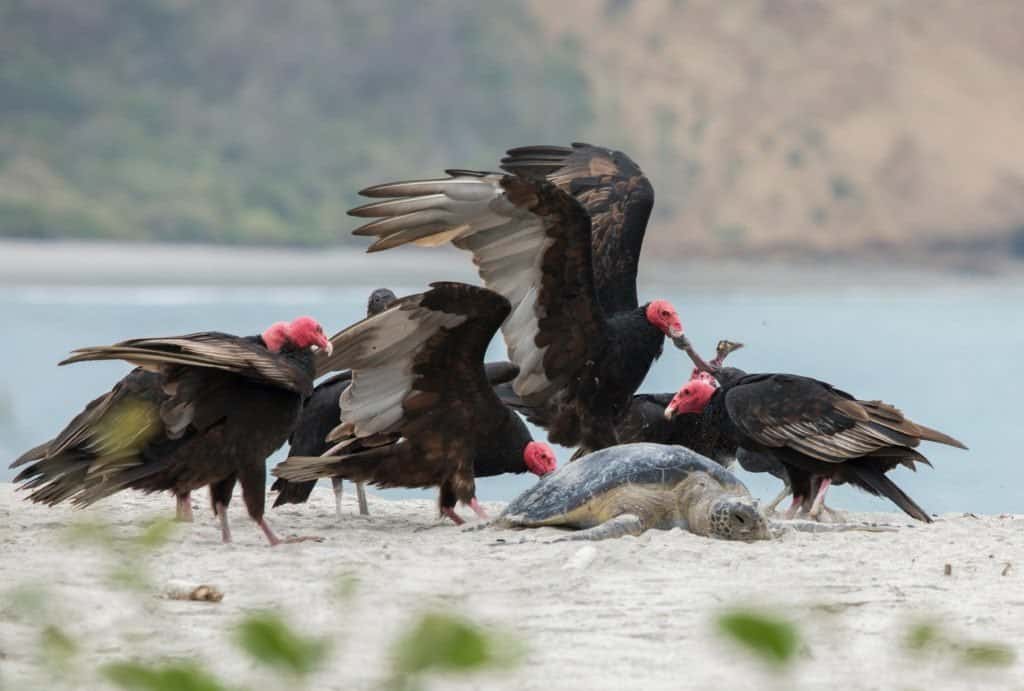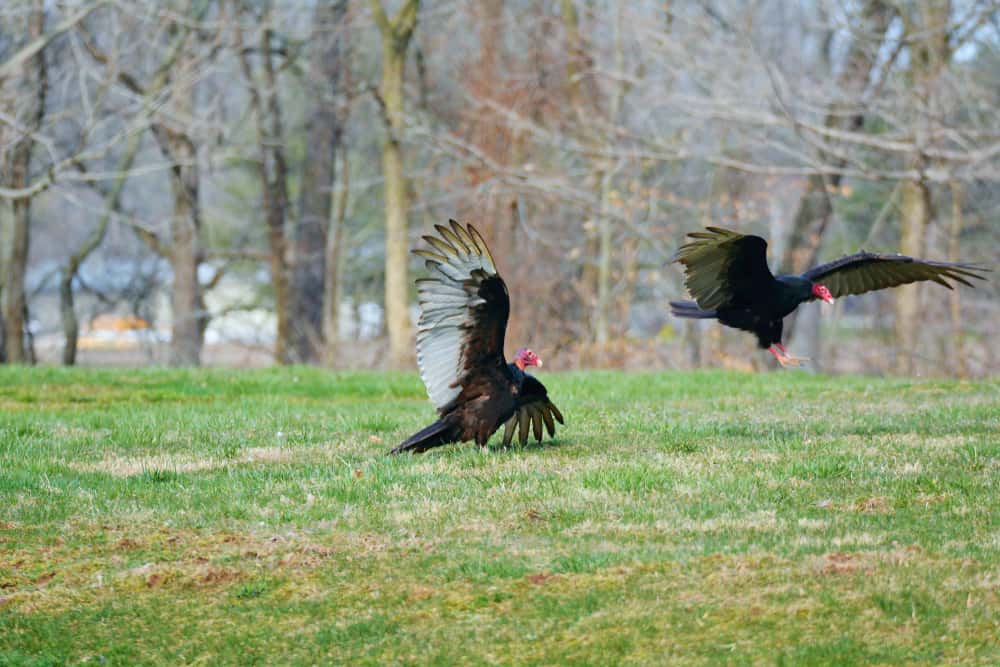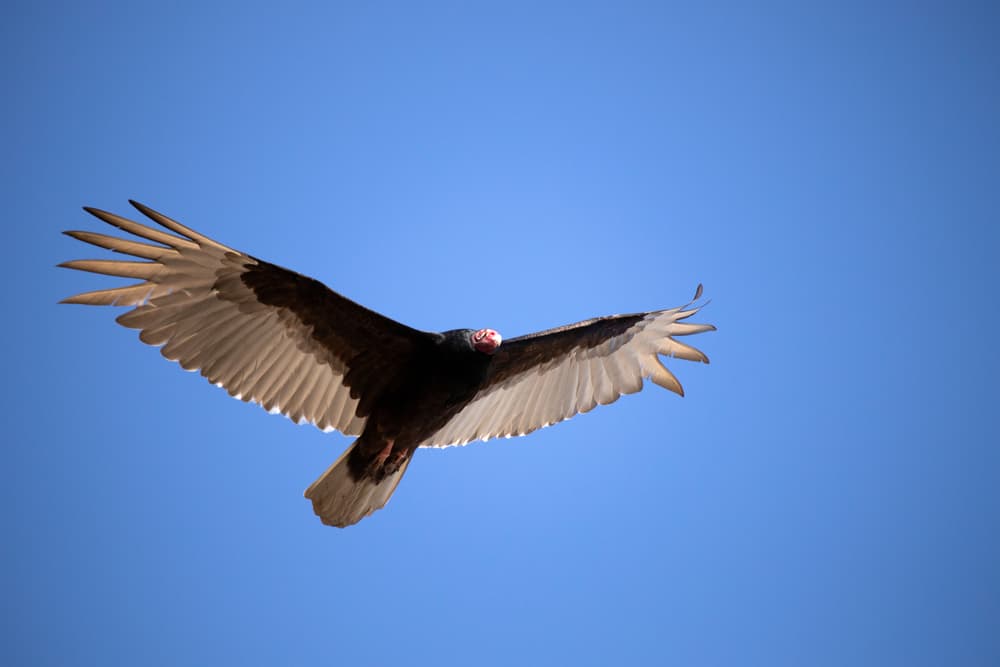Turkey vultures are commonly found in North America and even in South America. These vultures, which resemble turkeys, are known for their long wingspans and lazy flying patterns. But what do they eat? Many people know vultures to be scavengers, but their diet does not only consist of opportunistic meals and leftovers. So let’s find out what Turkey vultures eat.
The Diets of Turkey Vultures

What do Turkey Vultures eat? They eat carrion and dead or sick birds and mammals.
©Ana Dracaena/Shutterstock.com
Turkey vultures primarily eat carrion, young or sick birds and mammals. They are omnivorous creatures which means they have a vast diet that includes both plants and animals.
Carrion is the rotting flesh of an animal, and this is turkey vultures’ first choice of food. They will eat a decaying carcass but prefer a fresh corpse. Unlike many other vulture species, these vultures have a strong sense of smell, so they spend less time looking for food or carrion.
Turkey vultures will also eat dead birds, reptiles, amphibians, and invertebrates. Turkey vultures do not have a firm grip on their feet, meaning they consume most of the carrion where they find it. If these birds have no access to carrion, young or sick animals, they will eat other food like human waste, fruits and vegetables.
Turkey vultures are not the only animals who feed on carrion. They must compete with black vultures, lesser yellow-headed vultures, greater yellow-headed vultures, king vultures, and Andean condors. Also, black vultures are often their main competition, as they follow the turkey vulture and then fight it off once it finds carrion.
Complete List of Foods Turkey Vultures Eat
- Carrion
- Young Birds or Mammals
- Sick Birds or Mammals
- Human garbage
- Pumpkins
- Coconuts
- Juniper berries
- Grapes
What Do Turkey Vultures Look Like?
Turkey vultures have red heads and necks, similar to turkeys, and that’s where they got their name. Although they resemble turkeys, they are smaller than turkeys and shaped differently. These vultures also have brown plumage across their body and have “fingertips” at the tips of their wings.
Their wings are often white or grey on the underside, which is a strong identifier. These vultures have tails that are longer than their legs and are either red or white-grey. Their legs may seem white because of urohidrosis. Urohidrosis is when an animal, commonly done by birds, urinates on their legs to cool down. The dried uric acid causes a lighter color.
Turkey Vulture Size
Adult turkey vultures grow roughly 32 inches in length and can weigh up to three pounds. They have a large wingspan that reaches almost 6 feet long. Turkey vultures reach maturity at around two years old. At this point in their lives, their heads will fully redden, and they will have reached their full weight and size.
Male and female turkey vultures are often the same size and weight, unlike other vultures. This characteristic could be due to their diet, as these birds rarely hunt like other birds of prey.
Where Do You Find Turkey Vultures?
Turkey Vultures are commonly found in many states across the United States. You might also be lucky enough to see them in Canada and they migrate to Mexico, Columbia, and Ecuador during winter. Turkey Vultures are opportunistic with their diet and their nesting habits. These vultures will nest in empty nests and on ledges.
Depending on their location, turkey vultures choose to migrate to different places, while some don’t migrate at all. For example, turkey vultures in the southern parts of the United States often do not migrate as these areas are warm all year round.
On the other hand, turkey vultures found in the northeast parts of the United States migrate to places like North Carolina, and vultures found in the western parts of the country migrate all the way down to Venezuela, Colombia, and Ecuador.
The Mating Habits of Turkey Vultures

Turkey vultures participate in aerial courtship rituals to establish pair bonds.
©James W. Thompson/Shutterstock.com
Turkey vultures in North America often choose to breed in areas with as few humans as possible, like farmlands, rangelands, forests, and lower regions of mountains. These vultures do not build nests, which means they either find abandoned nests or lay their eggs on ledges, caves, hollow logs, or even on the ground.
Turkey vultures are monogamous animals, and pairs are known to remain together till death. These pairs are also known to reuse old nesting sites during every mating season.
Turkey vultures practice aerial courtship, which means one of them follows the other and mimic’s the other one’s flight path. Turkey vultures commonly lay two eggs but sometimes only one or up to three eggs. The incubation process is five weeks long and both vultures share in raising their young.
Once the eggs hatch, both vultures brood the young and feed the young through regurgitation. The young will fledge at 60 to 80 days and stay with their parents for one to three weeks after their first flight. At roughly 12 weeks old, the young would have left their parents and nesting area.
The Flying Habits of Turkey Vultures
Like other vulture species, turkey vultures circle as they fly. However, to circle, vultures use the thermals to stay in the air and cover a large area without using much energy. Thermals, better known as thermal columns, are warm air streams rising into the sky. Their large wingspan uses these thermals to rise, taking up less energy.

A circling Turkey Vulture looking for food.
©GarySang/Shutterstock.com
Turkey vultures often circle because they are looking for food. Sometimes they will continue circling after they have found the food to ensure that there are no other predators around the prey or carrion. Although turkey vultures have an impressively long wingspan, they are not the best fliers.
Turkey vultures are not good at flapping their wings as they cannot flap with enough power or strength. These vultures are known for their uneven flying patterns, earning this behavior the name of contorted soaring. This behavior is when turkey vultures use small-scale turbulences to stay in the air.
The photo featured at the top of this post is © hubert999/Shutterstock.com
Thank you for reading! Have some feedback for us? Contact the AZ Animals editorial team.






